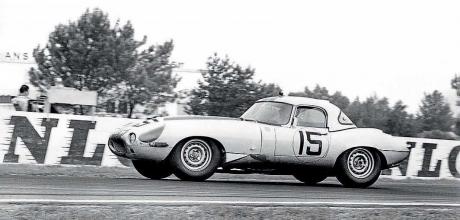Jaguar’s final Le Mans finish for over 20 years, 1963
Despite ruling Le Mans throughout the Fifties with five overall victories plus three second, two third and four fourth places, Jaguar’s dominance of the famous 24 Hours race came to an end in the early Sixties with a disappointing ninth place. When motorsport’s governing body, the FIA, introduced a new GT class for endurance racing from 1962 onwards, many privateers chose the new E-Type. The homologated version initially showed great promise with two examples finishing a strong fourth and fifth at 24 Heures du Mans in 1962 with the outfits of Briggs Cunningham and Peter Sargent.
FINISHING LINES
The former returned the following year with three of the new Lightweight models. The car weighed 114kg (250lb) less than a standard E-Type and the straight six engine now produced 310bhp, which was 45bhp more than a standard unit. With a roster of experienced drivers including Cunningham himself plus Roy Salvadori (who had won Le Mans in 1959 for Aston Martin) plus the occasional American Formula 1 driver, Walt Hansgen, the Florida-based team must have headed to France feeling confident.
That confidence, though, would ultimately prove to be misplaced. Car 14 which was driven by Hansgen and his American teammate Augie Pabst retired after just one hour due to gearbox problems. The number 16 E-Type with Salvadori at the wheel was involved in a major accident six hours into the race when he spun on a patch of oil left by the Aston Martin DP212 of Bruce Mclaren at the Mulsanne Kink after blowing its engine. “I knew I could not avoid the oil, and I thought that this was the end,” wrote Salvadori in his 1985 biography, Roy Salvadori Racing Driver. “I lifted my foot almost off the accelerator, leaving on just enough power to control the car, hit the oil, felt the car slide sideways, the wheels bit again as I mounted the grass.” Due to the force of the accident, Salvadori – who couldn’t get his seatbelt properly tightened after the last driver change – was thrown out of the car through the rear Perspex window. Thankfully other than a few bruises and being covered in petrol from the ruptured fuel tank, he was largely unharmed.
This left the number 15 car of Cunningham and his fellow American co-driver, Bob Grossman, which, thanks to initially running without any issues together with the race’s many retirements, looked to be heading for a solid top sixth place. But at 10am on the Sunday morning when the pair were leading the GT3000 class with Grossman at the wheel, the brake pedal linkage broke. After standing hard on the middle pedal at the end of the Mulsanne Straight at 165mph, nothing happened. Although he managed to take an escape road, he still smashed hard into a row of hay bales. Thankfully the American wasn’t hurt but the bonnet was bent in half, the radiator had sprung a leak, the front tyres were flat, and the headlamps hung lifelessly out of their sockets After contacting the team via a marshalling area, Grossman managed to nurse the stricken E-Type back to the pits. Amazingly, in just 74 minutes the mechanics managed to straighten the cross tube of the front subframe, fitted two new wheels, cannibalised parts from the abandoned Hansgen/Pabst car to replace the radiator and grafted a new front half of the bonnet. Following its return to the race, the E-Type then suffered from gear selection problems meaning the drivers had to leave the transmission in top. Cunningham and Grossman eventually finished in ninth, 56 laps behind the winning Ferrari which, considering the bad luck the team had endured all race, wasn’t a bad result. But it was still a long way from Jaguar’s glory days a few years earlier.
Although two E-Types were entered into the following year’s race, they both retired. With this being the final entry for a Jaguar in the famous event for two decades, it meant 1963 was the last time one of its cars finished at Le Mans until 1985 when another American team, Group 44, came home in 13th position with its V12-engined XJR-5. If 1963 marked the end of the Jaguar’s first golden era at the 24-hour race, then 1985 was the start of its second that would eventually lead to two more victories in 1988 and 1990.


